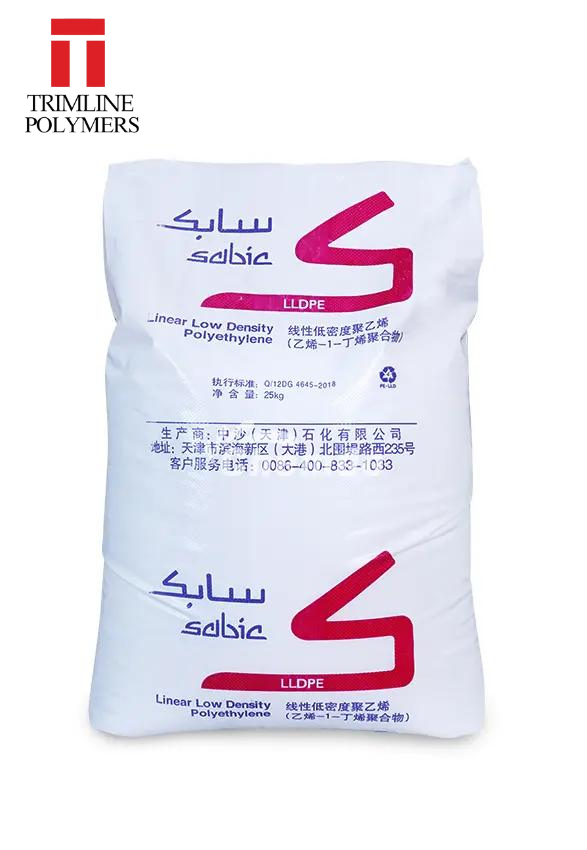Sabic 118WJ
Description
SABIC® LLDPE 118WJ is a butene linear low density polyethylene resin typically used for general purpose applications. Films produced from this resin are tough with good puncture resistance, high tensile strength and good hottack properties. The resin contains slip and antiblock additive. SABIC® LLDPE 118WJ is TNPP free. This product is not intended for and must not be used in any pharmaceutical/medical applications.
Typical Applications
Shipping sacks, ice bags, frozen food bags, stretch wrap film, produce bags, liners, carrier bags, garbage bags, agricultural films, laminated and coextruded films for meat wrap, frozen food and other food packaging, shrink film (for blending with LDPE), industrial consumer packaging, and high clarity film applications if blended with (10~20%) LDPE.
Typical Property Values
| Properties | Typical Value | Units | Test Methods |
|---|---|---|---|
| Density | g/m3 | 0.948 | GB/T1033.2-2010 |
| POLYMER PROPERTIES | |||
| Melt Flow Rate (MFR) | |||
| 190°C and 2.16 kg | 1 | g/10 min | ASTM D1238 |
| Density(1) | 918 | kg/m³ | ASTM D1505 |
| FORMULATION | |||
| Slip agent | √ | - | - |
| Anti block agent | √ | - | - |
| MECHANICAL PROPERTIES | |||
| Dart Impact Strength(2) | 145 | g/µm | ASTM D1709 |
| OPTICAL PROPERTIES(2) | |||
| Haze | 10 | % | ASTM D1003 |
| Gloss | |||
| at 60° | 60 | - | ASTM D2457 |
| FILM PROPERTIES(2) | |||
| Tensile Properties | |||
| stress at break, MD | 40 | MPa | ASTM D882 |
| stress at break, TD | 32 | MPa | ASTM D882 |
| strain at break, MD | 750 | % | ASTM D882 |
| strain at break, TD | 800 | % | ASTM D882 |
| stress at yield, MD | 11 | MPa | ASTM D882 |
| stress at yield, TD | 12 | MPa | ASTM D882 |
| 1% secant modulus, MD | 220 | MPa | ASTM D882 |
| 1% secant modulus, TD | 260 | MPa | ASTM D882 |
| Puncture resistance | 68 | J/mm | SABIC method |
| Elmendorf Tear Strength | |||
| MD | 165 | g | ASTM D1922 |
| TD | 300 | g | ASTM D1922 |
| THERMAL PROPERTIES | |||
| Vicat Softening Temperature | 100 | °C | ASTM D1525 |
Processing Conditions
Typical processing conditions for 118WJ are: Melt temperature: 195 - 215°C, Blow up ratio: 2.0 - 3.0.
Storage And Handling
Polyethylene resin should be stored in a manner to prevent a direct exposure to sunlight and/or heat. The storage area should also be dry and preferably do not exceed 50°C. SABIC would not give warranty to bad storage conditions which may lead to quality deterioration such as color change, bad smell and inadequate product performance. It is advisable to process PE resin within 6 months after delivery.
Environment And Recycling
The environmental aspects of any packaging material do not only imply waste issues but have to be considered in relation with the use of natural resources, the preservations of foodstuffs, etc. SABIC Europe considers polyethylene to be an environmentally efficient packaging material. Its low specific energy consumption and insignificant emissions to air and water designate polyethylene as the ecological alternative in comparison with the traditional packaging materials. Recycling of packaging materials is supported by SABIC Europe whenever ecological and social benefits are achieved and where a social infrastructure for selective collecting and sorting of packaging is fostered. Whenever 'thermal' recycling of packaging (i.e. incineration with energy recovery) is carried out, polyethylene -with its fairly simple molecular structure and low amount of additives- is considered to be a trouble-free fuel.
Disclaimer
Any sale by SABIC, its subsidiaries and affiliates (each a “seller”), is made exclusively under seller’s standard conditions of sale (available upon request) unless agreed otherwise in writing and signed on behalf of the seller. While the information contained herein is given in good faith, SELLER MAKES NO WARRANTY, EXPRESS OR IMPLIED, INCLUDING MERCHANTABILITY AND NONINFRINGEMENT OF INTELLECTUAL PROPERTY, NOR ASSUMES ANY LIABILITY, DIRECT OR INDIRECT, WITH RESPECT TO THE PERFORMANCE, SUITABILITY OR FITNESS FOR INTENDED USE OR PURPOSE OF THESE PRODUCTS IN ANY APPLICATION. Each customer must determine the suitability of seller materials for the customer’s particular use through appropriate testing and analysis. No statement by seller concerning a possible use of any product, service or design is intended, or should be construed, to grant any license under any patent or other intellectual property right.

